Ever rushed a wood project and faced the glue debacle? Discover the secrets to perfect drying times here!

One day while I was cleaning the house, I found some old pieces of furniture. Most of them were in usable condition, but some were broken.
However, I realized that they could be glued and used again. I then researched how long to leave the glue to dry.
Here’s the answer I found by interviewing several professional glue experts in my area.
So, let’s find out, How long does wood glue take to dry?
Wood glue takes about 30 minutes to dry sufficiently for light tasks like sanding. It fully cures and reaches maximum strength in approximately 24 hours. Factors like humidity, temperature, and glue amount can affect the drying time.
But there’s a lot more to know about the drying time of wood glue!

In this article, I’ll explore how long does wood glue take to dry by considering each factor that affects the drying time and I’ll tell you the best technique to make your wood glue dry faster.
Furthermore, I’ll answer some frequently asked questions as well.
Just keep reading!
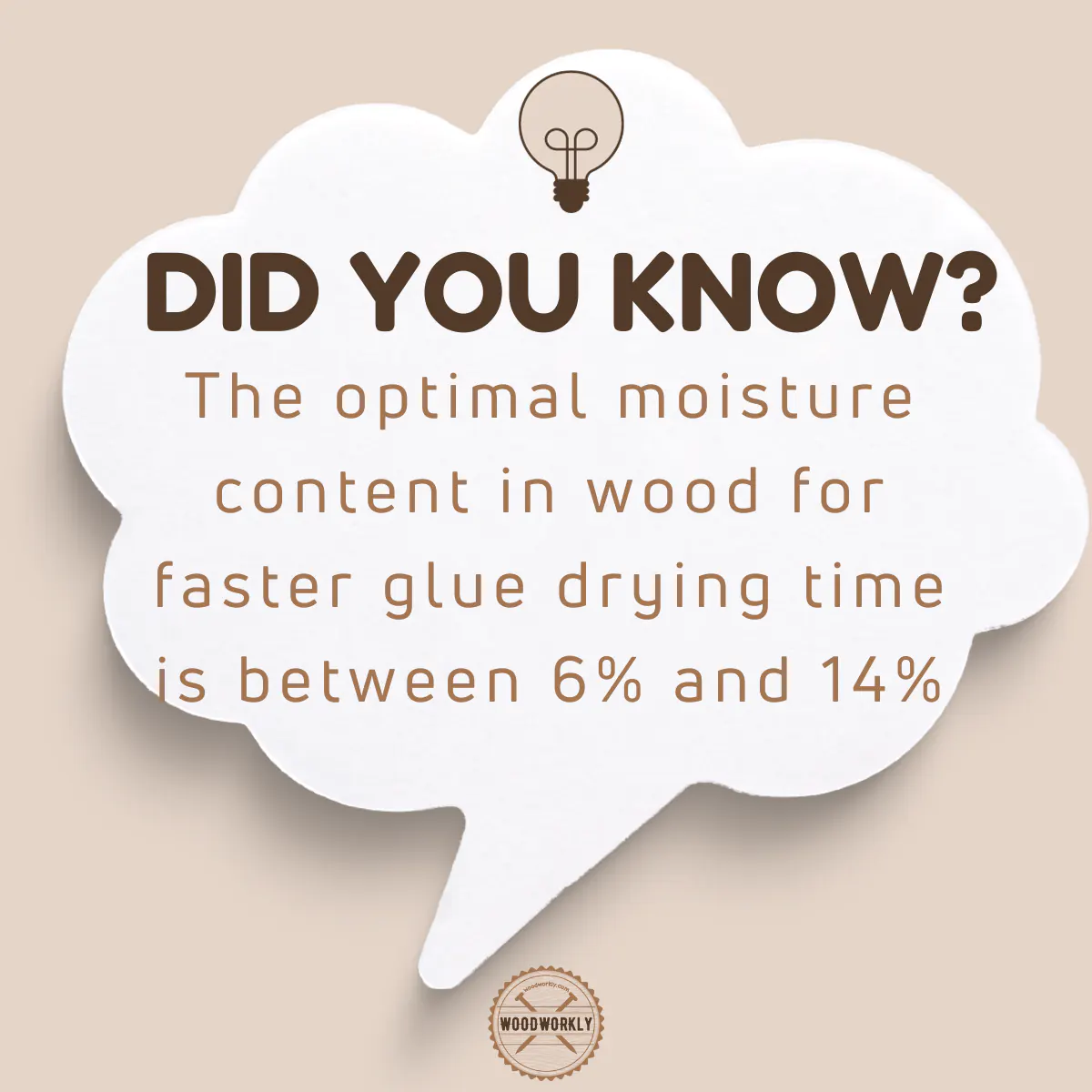
How Long Does it Take for Glue to Set on Wood?
Generally, wood glue takes 24 hours to set before unclamping the attached wood pieces.
After 24 hours wood glue will be completely set and the bond will be stronger than the wood itself.
After researching each and every wood glue that I met at local stores over the years, Here are some general guidelines for different types of glue:
| Type of Glue | Open Time (Working Time) | Clamp Time | Full Cure |
|---|---|---|---|
| White Glue (PVA) | 5-10 minutes | 15-60 minutes | 24 hours |
| Yellow Wood Glue (Aliphatic Resin) | 5-10 minutes | 30-60 minutes | 24 hours |
| Polyurethane Glue | 20-30 minutes | 1-2 hours | 24 hours |
| Cyanoacrylate (CA) Glue | Few seconds to 1 minute | Not necessary | Several hours to 24 hours |
| Epoxy Resin | 30 minutes to 1 hour | 1-2 hours | 24 hours |
| Hide Glue | 10-15 minutes | Several hours | 24 hours |
Note that “open time” refers to the time window in which you can still adjust the wood pieces after applying the glue, and “clamp time” refers to the time the glue takes to set enough to hold the pieces together without clamping.
For the best results, follow the instructions provided on the specific glue product you’re using, as different formulas may have different setting and curing times.
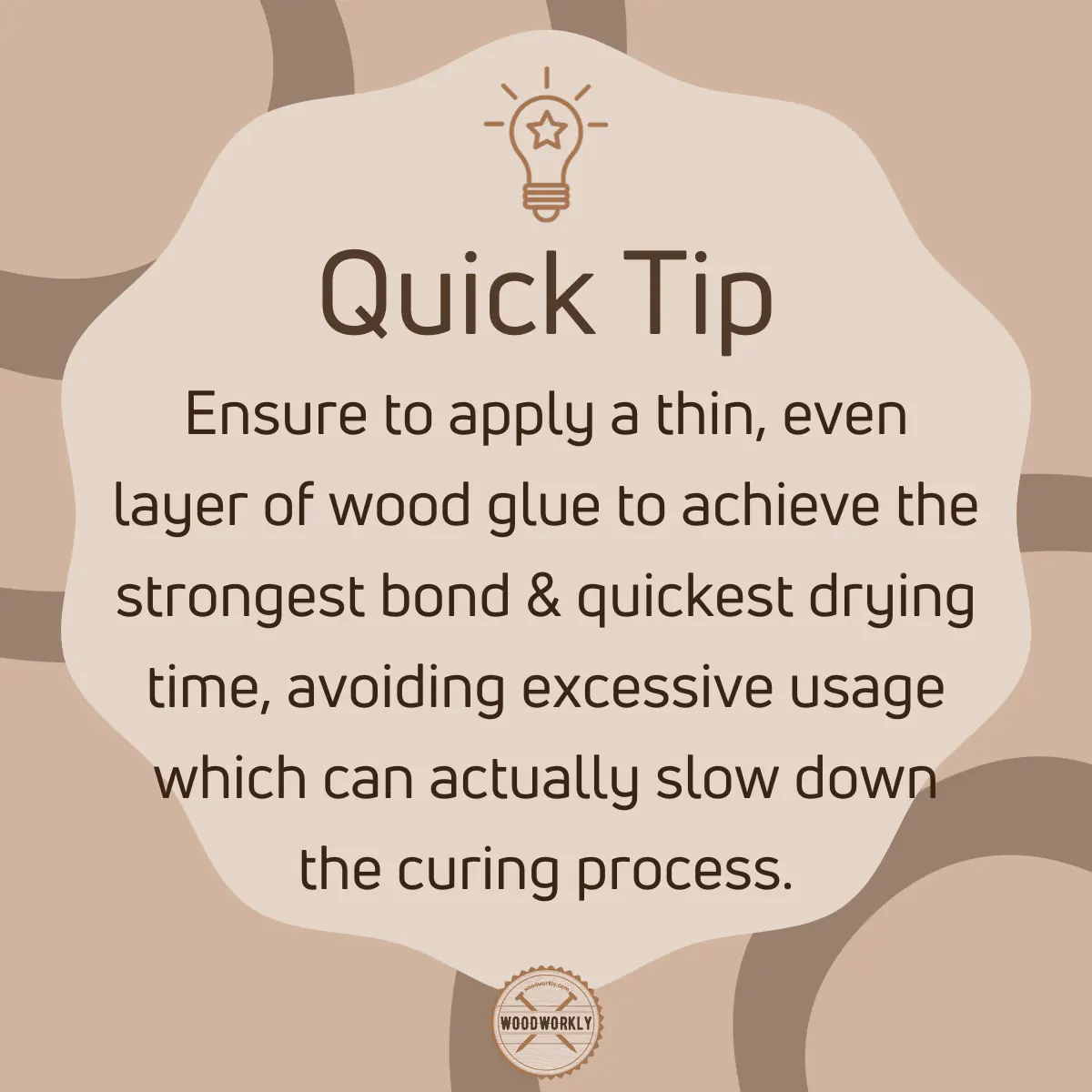
Factors that Affect the Drying Time of Wood Glue
Different types of wood glue take different amounts of time to dry, however, there are many factors that determine how long the type of glue you use will take to set and dry.
Temperature
Temperature is a major factor affecting the glue drying process.
Most wood glues dries faster at higher temperatures, so the drying time is less and the project can be completed quickly.
Wood glue dries slowly at low temperatures.
Therefore, it takes more time. In some cases, due to high temperatures, the wood glue dries faster, but the glue melts without being able to withstand the temperature.
Humidity
High humidity means an increase in moisture in the environment, i.e. an increase in the amount of water vapour.
Humidity is a critical factor affecting the drying time of many things, including wood glue.
The higher the humidity, the longer the glue takes to dry. Some glues, such as PVA, dry faster in dry air than in moist air.
Moisture
Before applying the glue to the wood, its moisture should be tested. If there is moisture in the wood, the glue dries slowly.
The moisture in the wood is removed through the wood, but when we apply glue, the moisture must pass through the glue, so the drying process is slow.
Dry wood should always be used to speed up drying and finish the project quickly.
Ventilation
Air circulation removes moisture from the atmosphere. This is where the dry air needed for quick drying is created.
Indoors, leaving windows open, running fans, in windy weather, or outdoors can cause glue to dry quickly.
Keep your working area ventilated for a fast and efficient wood glue drying process.
Wood type
Another important factor that affects the drying of the glue is the type of wood we use. Depending on the type of wood, the drying time is affected.
When using porous wood, it takes longer to dry. These many holes absorb a large amount of glue, thus delaying drying.
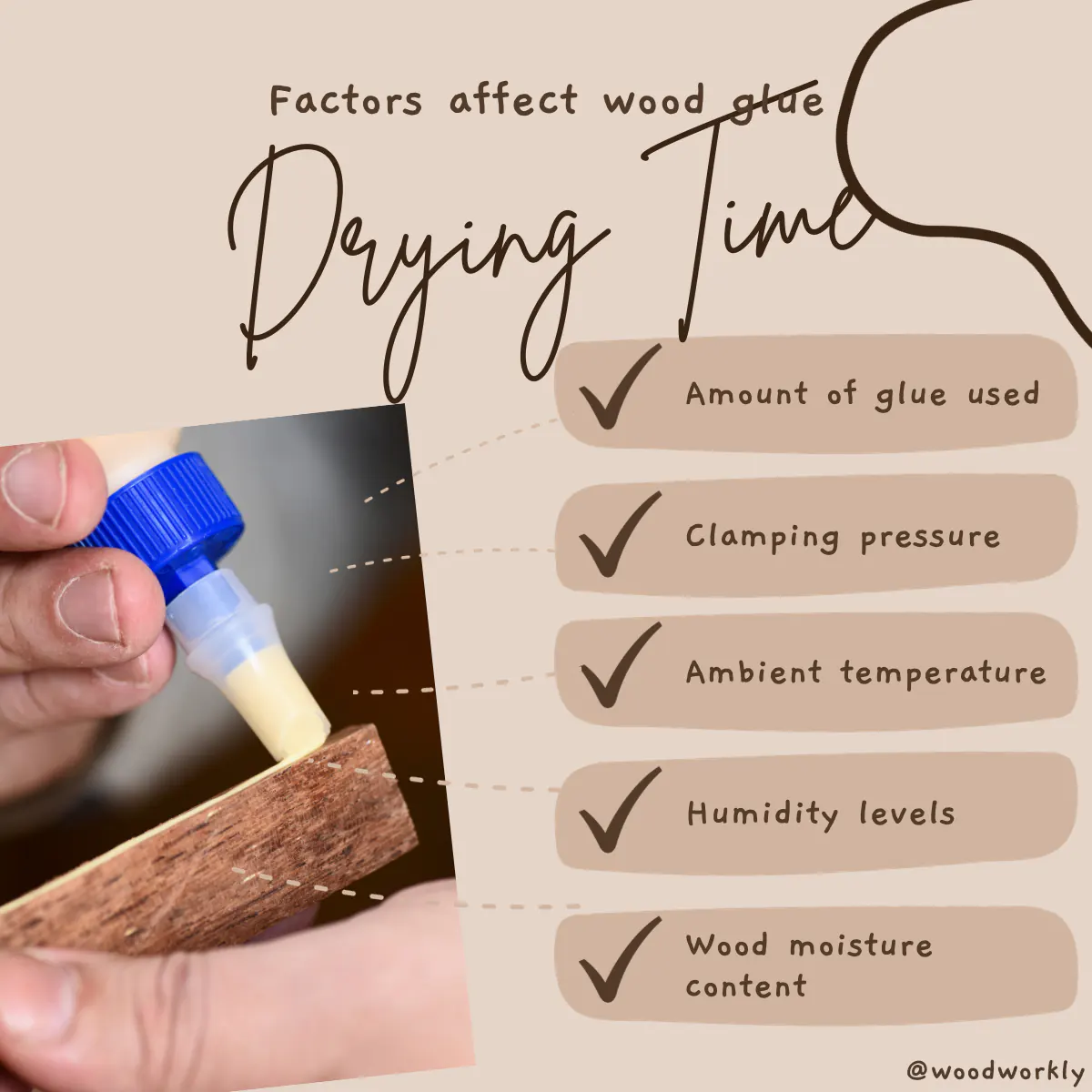
Differences Between Wood Glue Dry Time, Cure, and Set Time
In woodworking, drying, and curing can be used interchangeably, but the two concepts are not the same.
Dry when referring to wood glue is strong enough to hold without the aid of a clamp. It is understood that the glue is dry when the clamps of an attached joint can be removed.
But wood glue takes longer to cure.
Wood Glue Dry Time
Wood glue dry time is the time it takes for the glue to lose its wet appearance and become tacky to the touch.
The surface may seem dry, but the glue underneath might still be setting.
This stage generally indicates that the pieces can no longer be easily adjusted or moved, and the initial bond has been established.
Wood Glue Cure Time
Wood glue takes a long time to fully cure. Wood glue usually takes 30 to 60 minutes to dry and takes about 24 hours to fully cure.
Tighten non-stressed joints for 60 minutes or less and stressed joints for 24 hours. Moisture, temperature, type of wood, and type of glue affect drying time.
Wood Glue Set Time
The setting time of the wood glue is the time it takes for the wood glue to create a bond of sufficient strength between the pieces of wood being joined together.
When the glue hardens significantly, it is considered a set.

Drying Times of Different Types of Wood Glues
Now I’m going to share with you drying times, curing times and set times of different types of wood glue that we mostly use.
Note that following details were collected based on my own experience working as a woodworker for more than 30 years.
Plus, other details were collected from glue experts.
Let’s dig in!
Polyvinyl Acetate Glue
Polyvinyl Acetate Glue Drying time is about 10 – 30 minutes and curing time is about 18 to 24 hours.

Polyvinyl acetate, often referred to as PVA, is the best type of wood glue for furniture. It is specially formulated to penetrate wood pores and grain to improve its adhesion.
This mechanism holds the wood together using PVA glue to form a stronger bond than nailed joints. This adhesive is designed to work on a wide range of materials.
You can even use it to bond cardboard, paper, wood, and other materials.
This wood glue sets faster and forms a stronger bond than standard PVA craft glue due to these modifications.
The drying time of PVA glue ranges from 10 to 30 minutes. and 18 to 24 hours for complete curing.
PVA wood glue is available in fast-drying and slow-drying options. Fast-drying types require about 10 minutes to dry while slow-drying options take 25 to 30 minutes to dry.
In any case, the PVA glue will need at least 24 hours to cure and reach its strength.
Cyanoacrylate Wood Glue
Cyanoacrylate Wood Glue Drying time is about 30 seconds and curing time is about 8 hours.
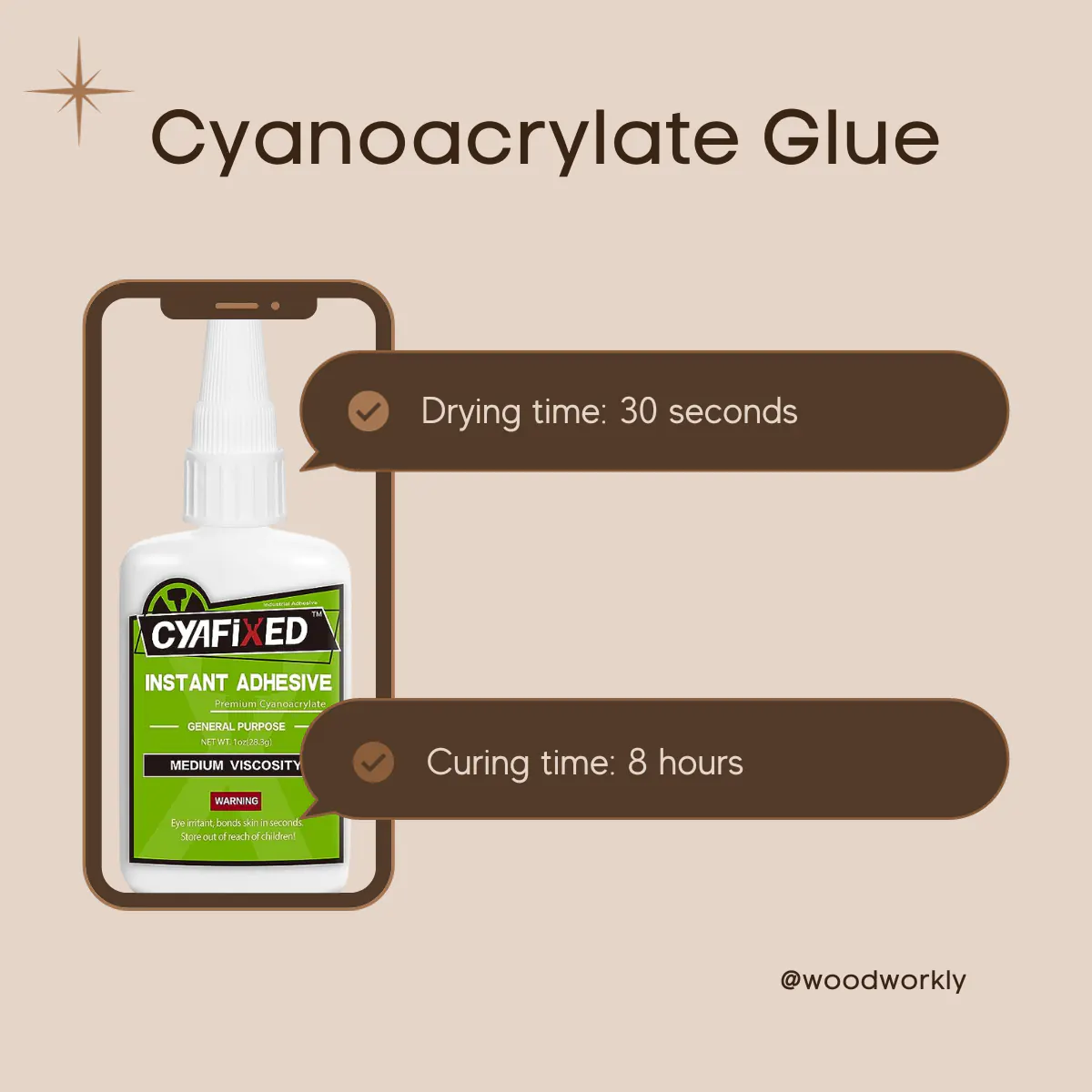
Cyanoacrylate or CA wood glues are better known as super glues or instant glues because of their fast drying time. This adhesive sets in seconds and forms strong bonds in minutes.
Super glue can set in less than 30 seconds to create a strong initial bond to wood or other materials. It takes about 8 hours to reach full strength.
These adhesives cure very quickly and can speed up your project timeline, and the bond they form is never something you want to rely on as a permanent fix.
Instead, woodworkers typically use CA glue to provide a temporary bond with a quick fix.
Cyanoacrylate glue is not as strong as PVA glue or epoxy when dry. For this reason, they are usually reserved for fixing fixtures and repairing small pieces of wood.
You can use superglue as a crack filler by mixing it with sawdust. During bond formation, the adhesive dries by drawing moisture from the surrounding air, giving off a temporary, characteristic odour.
CA glue is available in different thicknesses, so you can choose the glue to suit the project you want to use it for. Thicker varieties are often useful for attaching pieces of wood and filling gaps.
Aliphatic Resin Wood Glues
Aliphatic Resin Wood Glue Drying time is about 25 to 30 minutes and curing time is about 24 hours.
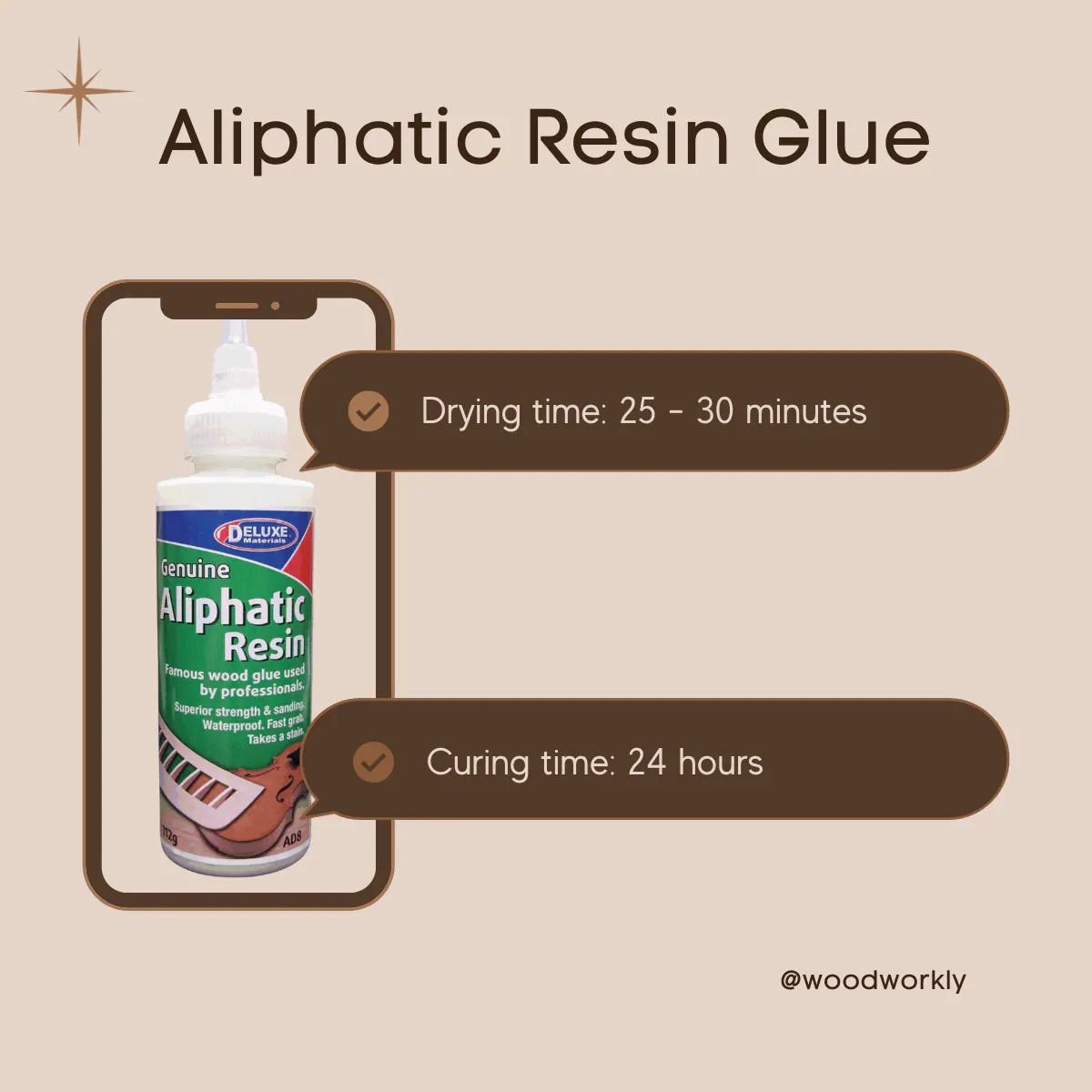
Aliphatic glue is another form of modified PVA glue. Therefore, their formula features the same polyvinyl acetate polymer as standard PVA craft glue.
Alibar resin glue may also be called yellow glue or carpenter’s glue. Many varieties get their yellow glue moniker from the yellow color they assume when dried.
Other varieties of this glue turn brown when dry, but they are the same product.
Aliphatic resin glues have similar drying times to PVA wood glues because they have the same basic formula.
You should press the standard varieties in 10 to 15 minutes, but the slow drying options will require more drying time. It can be around 25 to 30 minutes.
Unlike PVA glue, lymphatic glue takes approximately 24 hours to cure and reach full strength.
Polyurethane Glue
Polyurethane Glue Drying time is about 10 to 30 minutes and curing time is about 24 hours.

If you’re familiar with Gorilla Glue, chances are you’re not familiar with Polyurethane Glue. These adhesives typically expand when dry to form a super strong bond to join surfaces.
Therefore, excess glue and sand will need to be cleaned when dry when used normally.
This waterproof glue is versatile and can be used on metal and wood. Polyurethane adhesives are often waterproof, making them an excellent choice for outdoor joint projects.
Polyurethane glue is available in fast and slow-drying varieties. Fast drying options typically have drying times of 10 to 15 minutes, while slower varieties can take 30 minutes or more to dry.
It is advisable to keep the polyurethane glue for at least two hours for a strong bond. Most varieties take 24 hours to fully heal and reach full strength.
Epoxy Glue
Epoxy Glue Drying time is about 30 minutes and curing time is about 24 hours.
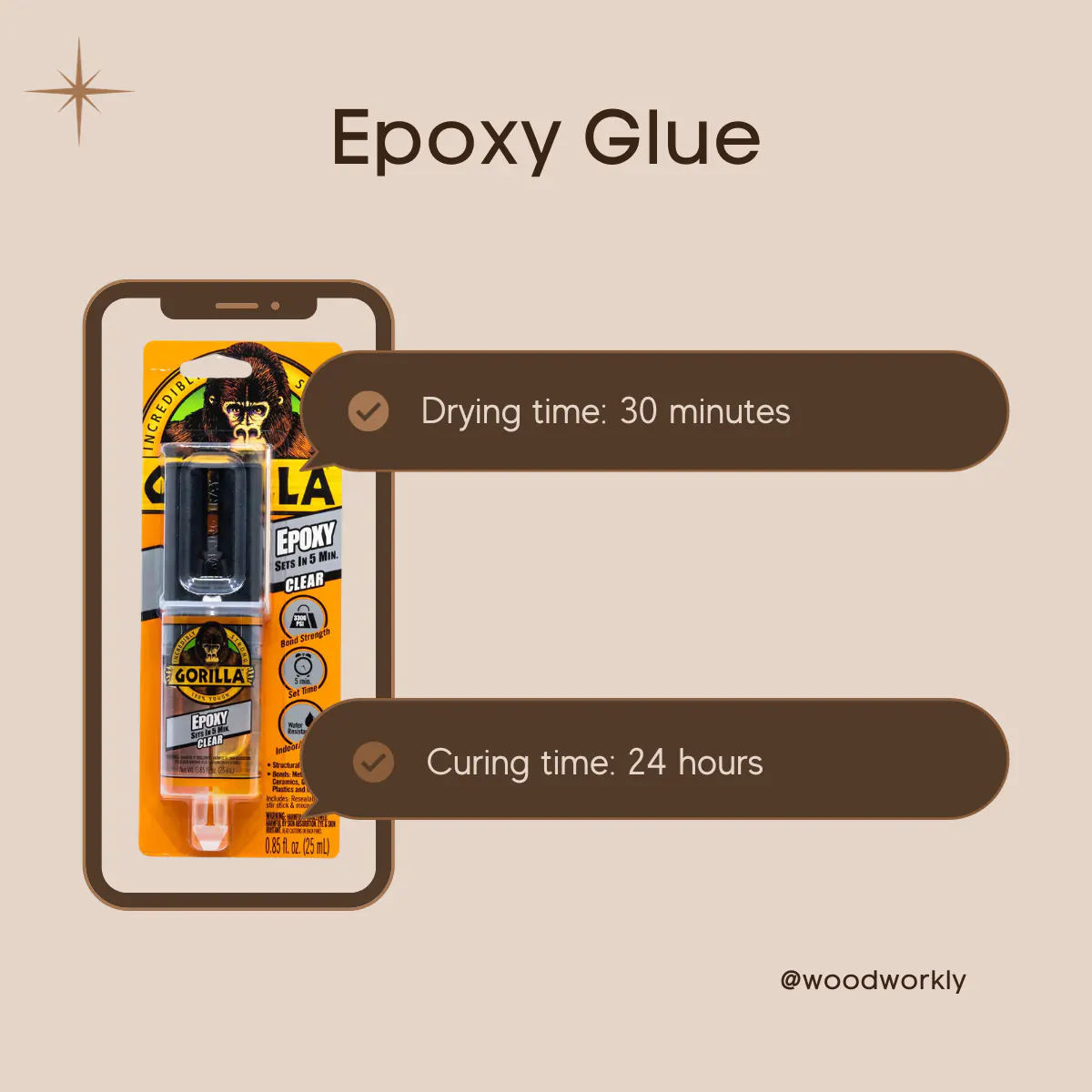
Epoxy is the most used adhesive in woodworking circles. It uses resin and hardener to create a strong bond that can replace other mechanical methods of attaching wood.
Once mixed, the hardener and resin form an epoxy adhesive.
Epoxy wood can be used as a filler for gaps and glue to attach wood pieces.
Epoxies may be best known for their use on wood, but they are formulated to bond a variety of materials other than wood.
Excellent resistance to water and chemicals makes it suitable for use in a variety of environments and outdoor applications.
Drying times for epoxy adhesives can be as little as one minute for fast-setting varieties that reach full strength in less than ten minutes.
Like many of the slow-drying wood glues discussed in this article, slow-drying options like Epoxy glue can take up to 30 minutes to dry. Most epoxy adhesives take about 24 hours to cure and reach full strength.
Hide Glues
Hide Glue Drying time is about 10 to 15 minutes and curing time is about 24 hours.

This type of glue is made from animal skin.
This is the only type of glue made from natural ingredients and is the result of years of research trials and tests to develop an effective formula.
This glue is not waterproof, so it is not suitable for use on outdoor projects. However, the natural formula means the hide glue is non-toxic and safe for the environment.
Hide glues dry relatively fast, considering their natural formula. They usually enable the clamps to be removed in 20 minutes depending on how they are set up.
However, as most adhesives have discussed, liquid hide adhesives take approximately 24 hours to reach full strength.
When using hidden glue, you can skip the clamping. Instead, you put hot hide glue on both surfaces and rub them together a few times until the joint stops moving.
Hot Glue
Hot Glue Drying time is about 2 to 3 minutes and curing time is about 24 hours.

This type of glue is also known as hot melt glue. They are available in stick form that must be melted by pushing through a hot glue gun nozzle.
Most woodworkers stay away from hot glues because they melt and turn back to liquid when heated.
Their poor heat resistance puts them at a significant disadvantage for serious woodworking projects that may be subject to varying temperature conditions.
In any case, depending on the amount of glue used, hot glue can be set in less than a minute. In addition, the glue often needs about five minutes to cure and gain full strength.
Read to know How to use hot glue on wood!
Gorilla Wood Glue
Gorilla Wood Glue Drying time is about 20 to 30 minutes and curing time is about 24 hours.

This adhesive is ideal for the quick completion of projects. Ideal for use on hardwood, softwood, and natural wood composites.
Quickly creates an incredibly strong adhesive for wood projects.
Can be used indoors or outdoors due to its water resistance. Can be used as an interior or exterior wood adhesive for all types of woodworking projects and repairs.
Only 20-30 minutes of clamping time is required with complete healing in 24 hours.
Check out, How to Remove Gorilla Glue from Wood? (EASY Guide!)
TiteBond Wood Glue
TiteBond wood glue consists of several types. Now I’m going to discuss each considering their drying time, setting time, and curing time.
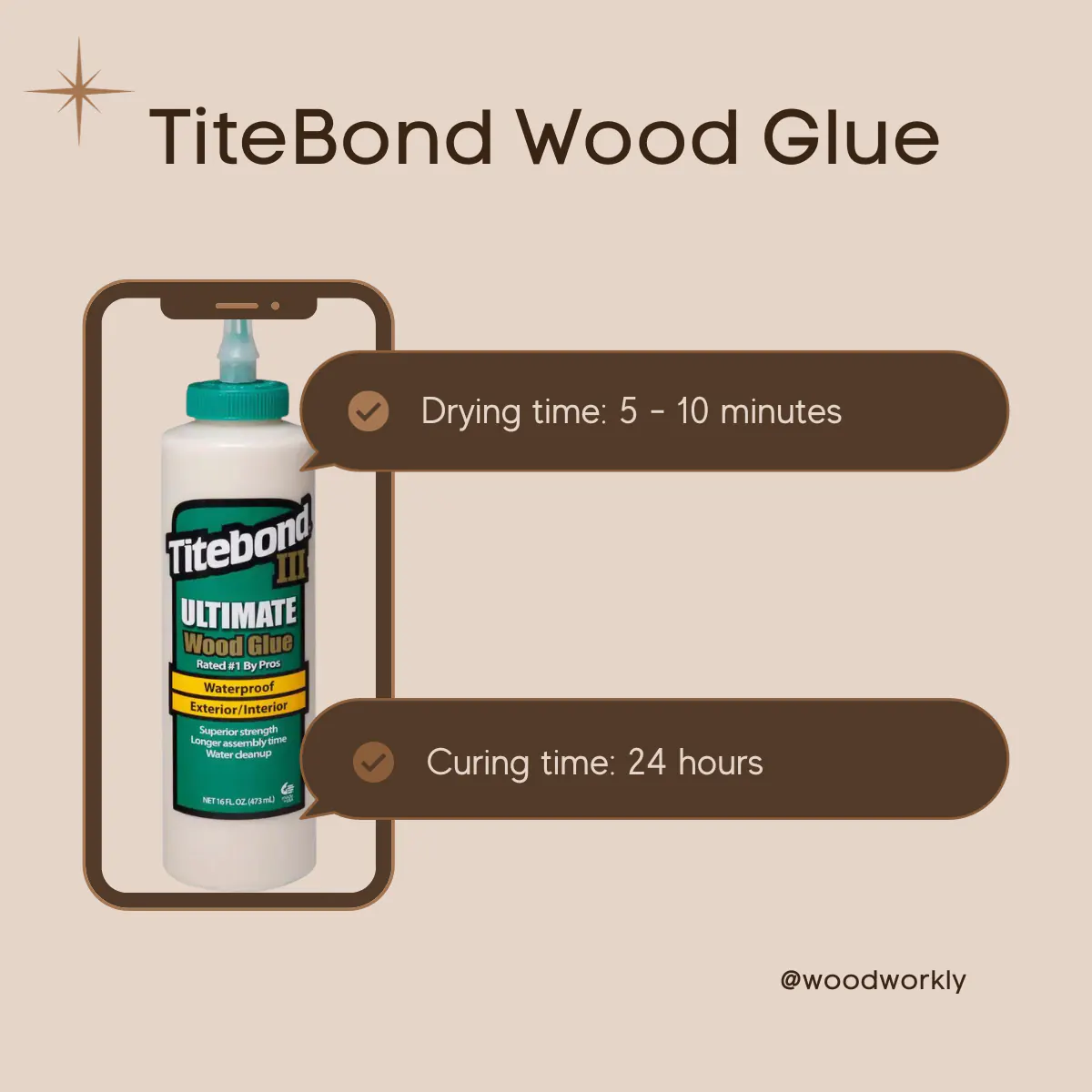
Just keep reading!
Titebond III Ultimate Wood Glue
TiteBond III ultimate wood glue has superior bond strength and low application temperature. Titebond III is non-toxic and safer to use than traditional waterproof wood glues.
Open assembly time is 8-10 minutes and full assembly time is 20-25 minutes. Required pressure varies from soft 100-150, medium 125-175, hard 175-250.
TiteBond II Premium Wood Glue
It is ideal for exterior woodworking projects including outdoor furniture, birdhouses, mailboxes, planters and picnic tables.
Open assembly time is 3-5 minutes and full assembly time is 10-15 minutes. Required pressures are in various ranges like soft 100-150, medium 125-175, and hard 175-250.
TiteBond Original Wood Glue
TiteBond Original is an easy-to-use, non-toxic, water-cleanable adhesive that helps achieve the highest quality finish.
It is suitable for wood, hardboard, particleboard, leather, fabric, and many other porous materials.
Open assembly time is 4-6 minutes and full assembly time is 10-15 minutes. Required pressure ranges from soft 100-150, medium 125-175, and hard 175-250.
TiteBond Genuine Hide Glue
It is a popular adhesive among many due to its long assembly time and exceptional strength. It does not need to be mixed or heated.
Open assembly time is 10 minutes and full assembly time is 20-30 minutes. Required pressure ranges from soft 100-150, medium 125-175, and hard 175-250.
TiteBond Polyurethane glue
Titebond Polyurethane Glue is a special type of adhesive in adhesive technology. It is a multi-purpose, professional strength adhesive specially formulated for multi-purpose applications.
Titebond Polyurethane Glue is an ideal adhesive for metals, ceramics, most plastics, HPL, Corian®, stone and other materials.
Total assembly time is 20-30 minutes with a 45-minute curing time. Required pressure ranges from soft 100-150, medium 125-175, and hard 175-250.
TiteBond Quick and Thick Multi-surface Glue
Titebond Quick & Thick Multi-surface Glue is the fastest-drying water-based adhesive available for use with porous and semi-porous materials.
It is suitable for wood, ceramics, ceramics, stone, glass, fabric, leather and many other materials.
Open assessment time is 3-5 minutes and full assembly time is 10-15 minutes. Required Pressure Soft 100-150, Medium 125-175, Hard 175-250
TiteBond instant bond wood adhesive glue
Designed primarily for wood and wood products, this adhesive is also very effective for other materials.
It takes about 5 – 15 seconds to set up. Initial healing takes 30-60 seconds and complete healing takes 8 hours. Required pressures are in the range of soft 100-150, medium 125-175, and hard 175-250.
TiteBond II extend
Titebond II Extend Wood Glue is an excellent weather-resistant adhesive.
It takes about 5 – 15 seconds to set up. Initial healing takes 30-60 seconds and complete healing takes 8 hours. Required pressure ranges from soft 100-150, medium 125-175, and hard 175-250.
Elmer’s Wood Glue
Elmer’s Wood Glue consists of several types.
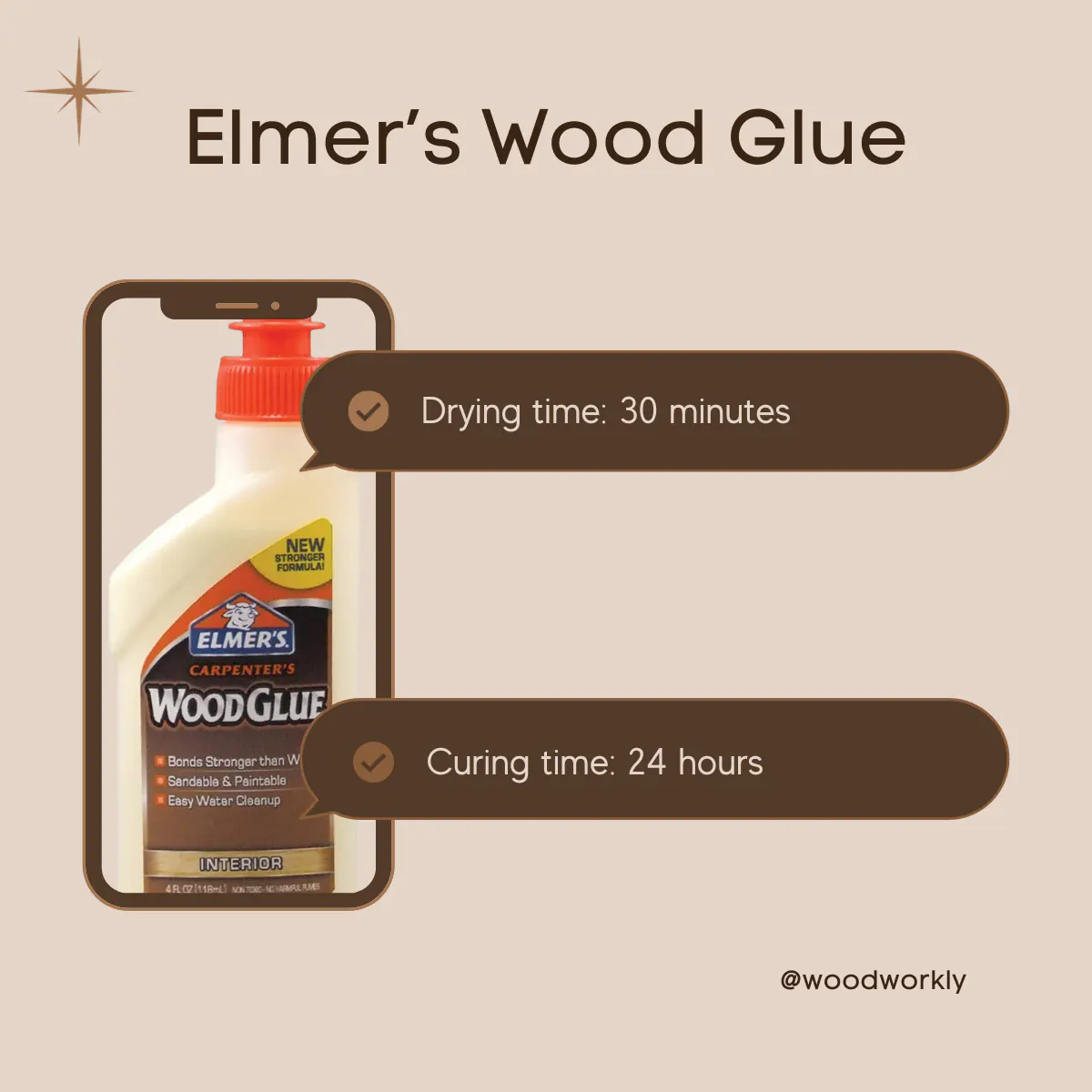
So, let’s talk about their drying times and curing times in detail based on my own experience.
Elmer’s Carpenter’s Wood Glue
Weldwood Professional Wood Glue is a premium-grade glue that provides fast, strong bonds to most porous and moderately porous materials.
Great for carpentry and home repairs. On-toxic has no harmful fumes and is easy to clean with water.
Elmer’s Carpenter’s Wood Glue takes 20 to 30 minutes for clamping time, and 24 hours for complete bonding.
Elmer’s Carpenters Wood Glue Max
Only waterproof and stainable wood glue is available. Heat resistant. Non-toxic and can be cleaned with water. Great for indoor and outdoor projects.
The duration of the open meeting is 10-15 minutes. The clamping time is 30 minutes and the total bonding time required is 24 hours.
Elmer’s ProBond Advanced
Weldwood Professional Wood Glue is a fast, strong bond-forming adhesive for most porous and semi-porous materials. Provides high stability and good water resistance.Suitable for bonding metal, glass, ceramics, wood, stone, and concrete.
Elmer’s ProBond Advanced takes 20 to 30 minutes clamping time, complete bonding takes about 24 hours. The duration of the open meeting is 8 – 10 minutes.
Elmer’s Glue-All
Elmer’s Glue-All is a non-toxic glue specialty. Ideal for household jobs, crafts, and school projects, Elmer’s Glue-All is a quick-drying glue.
Elmer’s Glue-All takes an Open assembly time is 30 minutes and a clamping time is 35 minutes. The total bonding time required is about 24 hours.
Elmer’s Glue-All Max
This glue does not require mixing other materials. Suitable for waterproof indoor or outdoor use.
Elmer’s Glue-All Max takes an Open assembly time is 30 minutes. The clamping time ranges from 1-4 hours and the total bonding time required is 24 hours.
How Long to Clamp When Using Wood Glue
Clamps are needed to put enough clamping pressure on the joint to allow it to bond correctly to ensure your project stays together.
To require clamps, use hidden glue and create a rubbed joint. This is basically putting hot hide glue on both surfaces and rubbing them together a few times until they stop moving.
This type of hidden adhesive holds the joint in place without tightening.
One option is to create your own clamp board if you’ve run out of clamps or don’t have the right type.
How long should the wood glue dry before removing the clamps?
If a joint you pressed is under stress, allow the glue to fully cure for 24 hours. Non-stressed joints can be removed in less than an hour.
Do not do anything that puts stress on the joint for less than a day because the ligament has not fully healed.
Your weather and climate should also be taken into consideration. If you’re in a cold, wet location, the glue will take longer to set and cure.
If you’re in a hot and dry environment, like the Southwest in the summer, you’ll usually be safer removing your project sooner.
Leading brands such as Timebound and Elmer’s recommend pressing a stress-free wood glue joint for 30 minutes to an hour.
However, tension joints require a longer wood glue clamping time. The new joint should be left unstressed for at least 24 hours to keep the boards in place.
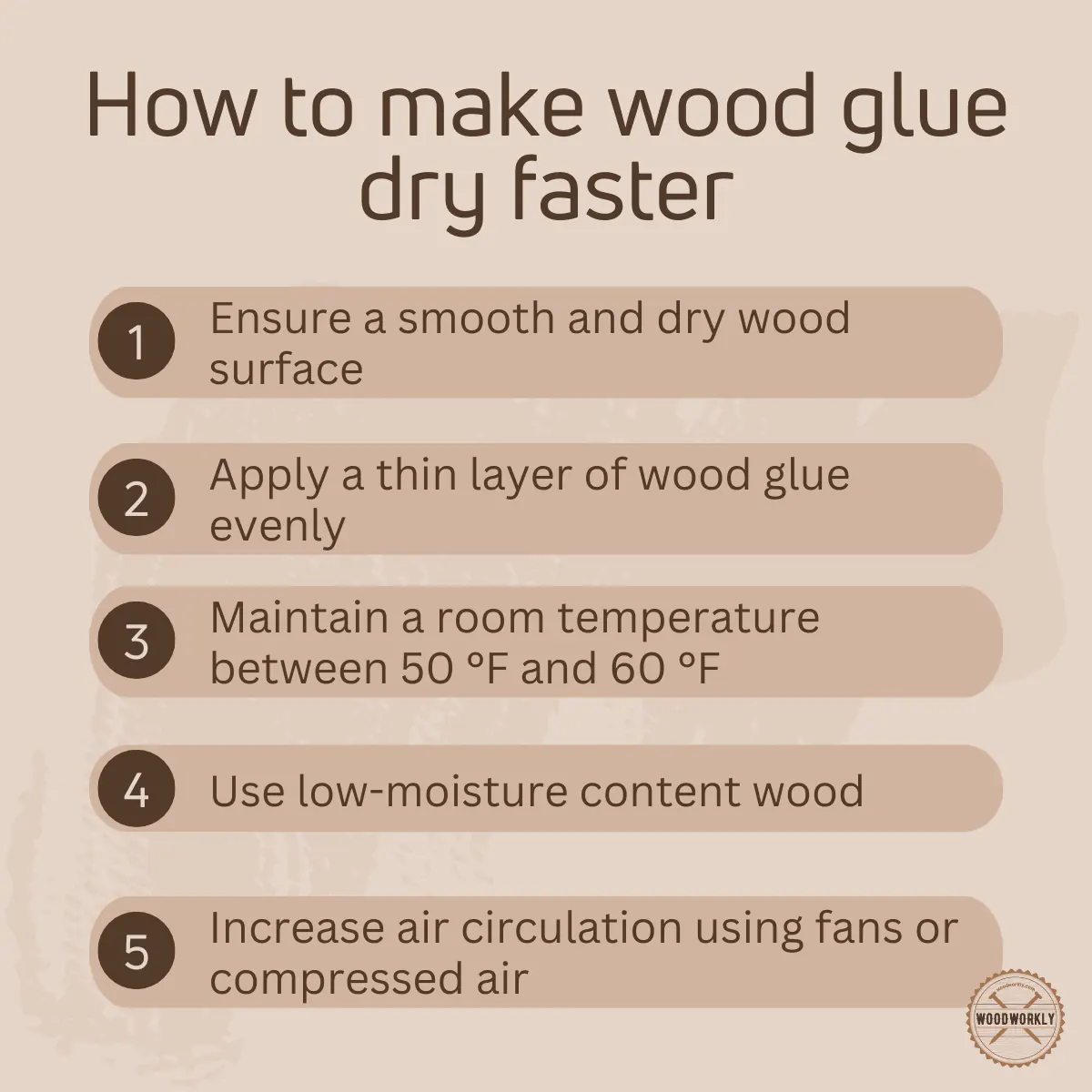
How to Get Wood Glue to Dry Faster
It’s always a good idea to give wood glue plenty of time to dry.
But sometimes you don’t have time to wait and knowing how to dry wood glue quickly can speed up the drying process.
So here are some easy tips for quick-drying glue that I use for my woodworking projects.
Increase Ambient Temperature
Temperature is one of the main criteria for drying. If the weather is not hot, you can increase the heat to speed up the drying process and finish the project in less time.
Heat can be raised by using a hair dryer or your home’s HVAC (Heating, Ventilation, and Air Conditioning) system to raise the ambient temperature.
Heat causes moisture on your glue to evaporate faster and dry faster.
Control the Humidity
Humidity is another major barrier to drying. Wood glue dries more slowly in humid conditions when there is a lot of atmospheric moisture in the air.
If working at home, you can use a dehumidifier to reduce the amount of water vapor in the atmosphere to an acceptable level.
Alternatively, you can use a hair dryer to speed up the drying process by raising the temperature and removing moisture from the air around your project.
Fans are also a great way to reduce humidity.
Use a Heat Gun or Hair Dryer
A heat gun or a hairdryer can be used to gently heat the glued area, which will help accelerate the drying process.
Be cautious to not overheat the area, as it might weaken the bond or cause damage to the wood.
Use a Quick-Setting Glue
Instead of using traditional wood glues, you can opt for quick-setting variants which are formulated to dry and cure faster. Products like cyanoacrylate adhesives are known for their rapid setting times.
Some adhesives are often thinned and run too thin for some applications. Diluting the glue can serve a purpose in that it introduces more moisture that the glue must lose through evaporation to dry.
Work in a Well-Ventilated Area
Working outside can ensure natural ventilation and fast drying without additional operation.
However, if you work indoors, you can keep overhead fans running. Windows can be opened to increase air circulation. Or you can blow a fan directly on the attached pieces that you want to dry.
Any one or a combination of these tactics should do the job of improving ventilation around your workspace.
Clamping
Proper clamping can help reduce the glue’s drying time by ensuring that the glue line is thin and even, which allows for a quicker setting and curing process.
However, make sure not to over-clamp as it can squeeze out too much glue, weakening the bond.
Thin Application of Glue
Applying a thinner layer of glue will reduce the drying time. Ensure to spread the glue evenly across the surface to form a strong bond without excessive squeeze-out.
Avoid using more glue than necessary as it will only increase the drying time.
The thickness of the glue causes it to take longer to dry. One way to ensure it dries quickly is to keep the quantities as small as possible.
Using less glue means the drying process takes less time, allowing you to complete the project faster.
There are several ways to reduce the amount of glue used in woodworking. One way is to use wooden glue bottles for dispensing.
This helps to get the right amount of glue without squeezing too hard and making a mess.
UV Curing
In cases where UV-curable adhesives are used, exposing the glued joint to UV light can significantly speed up the curing process.
This is a specialized process and is generally not applicable to common woodworking glues.
Use Dry Wood Pieces
Damp wood should be removed whenever possible. The extra moisture in the fibers and the glue will hinder moisture evaporation, mainly if you use water-based glue like PVA glue.
Moisture from the adhesive usually escapes directly from the glue into the air and some escape through the substrate.
If the wood is already saturated with moisture, there is no place for water particles from the glue to pass through the wood. This can slow down the drying process.
Using dry wood chips ensures enough space for water particles to escape and wood glue dries faster.
Congrats folks! Now you know exactly how long does wood glue take to dry with all about the drying and curing times of different wood glue types.
So, let’s answer some frequently asked questions.
FAQs
How long does it typically take for wood glue to dry?
Wood glue generally takes about 30 minutes to set sufficiently for light work such as sanding, and it fully cures and attains its maximum strength in approximately 24 hours.
What factors influence the drying time of wood glue?
The drying time of wood glue can be influenced by various factors such as the amount of glue used, the ambient temperature and humidity, and the moisture content in the wood being glued.
Should I wait for the glue to dry before removing the clamps?
Yes, you should wait for at least 30 minutes before removing the clamps to allow the glue to set adequately, and in cases of higher stress on the joint, you can leave the clamps on for up to 24 hours.
Can the drying time of wood glue be accelerated?
While it is not advisable to rush the drying process excessively, ensuring a smooth wood surface, applying an appropriate amount of glue, and maintaining optimal temperature and humidity conditions can potentially speed up the glue drying time.
How does humidity affect the wood glue drying time?
High humidity levels can extend the drying time of wood glue as it reduces the rate at which moisture evaporates from the glue, hence delaying the curing process.
How long should I wait before sanding the wood glued surface?
You can begin light sanding by hand after about 30 minutes of applying the glue; however, for using a sander, it’s recommended to wait a bit longer, ideally until the glue has cured more substantially.
When is it safe to paint over a wood-glued surface?
It’s best to wait for 24 hours to ensure the glue has completely cured and all moisture has evaporated before you begin painting over a wood-glued surface.
Did I cover all you wanted to know about: How Long Does Wood Glue Take to Dry
In this article, I’ve deeply discussed how long does wood glue take to dry by taking different types of wood glues with their drying time and I explained easy tricks that can make your wood glue dry faster.
Wood glue generally sets in about 30 minutes, allowing for light work such as sanding. However, it takes approximately 24 hours to fully cure and attain its maximum strength, with the bond becoming even stronger than the wood itself. Factors such as temperature and humidity can influence the drying time.
Furthermore, I’ve answered some frequently asked questions as well.
Hope you’ve learned everything you wanted to know about how long does wood glue take to dry according to the experts in the industry.
Now it’s time to select the wood glue that suits you the most and let it dry recommended time to get the perfect bond you looked for.